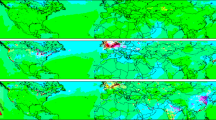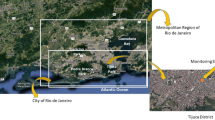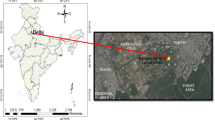Abstract
Goal, Scope and Background
Photochemical ozone creation potentials (POCPs) typically used in life cycle impact assessment (LCIA) to address the impact category ‘photo-oxidant formation’ only provide factors for particular volatile organic compounds and do not take into account background concentrations and meteorological conditions. However, the formation of ozone from volatile organic compounds (VOCs), carbon monoxide (CO) and nitrogen oxides (NOx) is highly dependent on the background pollutant concentrations and meteorological conditions. Some LCIA manuals therefore recommend working with potentials for high background concentrations of NOx (Derwent 1998), and potentials for low background concentrations of NOx (Andersson-Sköld 1992).
Objectives
This study has introduced an improved set of POCPs independently of meteorological and emission conditions specific to a given period or location. Whereas current POCP values may be relevant to estimate the photo-oxidant formation over a certain (temporally and spatially well-defined) domain, this study has further introduced more relevant values with respect to potential impacts of ozone on human health and environment.
Methods
For the computation of POCP values on the scale of Western Europe, independently of meteorological and emission conditions specific to a given period or location, a Eulerian chemistry-transport numerical model (CHIMERE-continental) has been implemented over three summer seasons. POCPs have been evaluated for ten VOC species (including the whole VOC group), CO and NOx. The coherence of this new set of POCP values with previous studies has been checked. The spatial representa-tivity of POCP values over the simulation domain in Europe has also been addressed. The robustness of these POCP values to changes in the implemented chemical mechanism used in our model has been checked.
Results and Discussion
The POCPs computed in this study were generally lower than the POCPs calculated in previous studies. In the previous studies, but not here, the POCPs have been calculated with particular meteorological conditions (during anti-cyclonic, fair weather conditions) or emission levels (high polluted backgrounds) known to be optimal with respect to ozone formation. Despite the quantitative variations in the POCP values, we have found a good agreement in the relative ranking of the pollutant species between this study and previous studies. It was also shown that POCP values display significant spatial variability over Western Europe (the largest spatial differences were obtained for NOx where the sign of the POCP value even changes from region to region).
Conclusions
Finally, the temporally and spatially averaged values obtained here for the POCP index update previous values and represent an attempt to generate the most appropriate and accurate scale for European conditions independently of meteorological and emission conditions specific to a given period or location.
Recommendations and Outlook
These new PCOPs should be useful to LCIA-practitioners in further life cycle impact assessment. However, for the NOx species, we do not recommend the use of the POCP value for LCIA.
Similar content being viewed by others
References
Andersson-Sköld Y, Grennfelt P, Pleijel K (1992): Photochemical ozone creation potentials: a study of different concepts.J. Air Waste Management Association, 42 (9) 1152–1158
Andersson-Sköld Y, Holmberg L (2000): Photochemical ozone creation potentials (POCP) and replacement of solvents in Europe. Atmospheric Environment, 34, 3159–3169
Atkinson R, Baulsch DL, Cox RA, Hampton RF, Kerr JA, Rossi MJ, Troe J (1997): Evaluated kinetics, photochemical and heterogeneous data. J Phys Chem Ref Data 26, 3, 521–1012
Bowman FM, Seinfled JH (1994a): Fundamental basis of incremental reactivities of organics in ozone formation in VOC/NOx mixture. Atmospheric Environment 28, 3359–3368
Bowman FM, Seinfled JH (1994b): Ozone productivity of atmospheric organics. J Geophys Res. 99, n D3, 5309–5324
Carter WPL (1994): Development of ozone reactivity scales for volatile organic compounds. Journal of the Air and Waste Management Association 44, 881–899
Darnall KR, Lloyd AC, Winer AM, Pitts Jr JN (1976): Reactivity Scale for Atmospheric Hydrocarbons Based on Reaction with Hydroxyl Radical. Environ Sci Technol 10, 692–696
DeMore WB, Sander SP, Golden DM, Hampson RF, Kurylo MJ, Howard CJ, Ravishankara AR, Kolb CE, Molina MJ (1997): Chemical kinetics and photochemical data for use in stratospheric modeling. Evaluation 12, JPL publication 97, 4, JPL, Pasadena, US
Derognat C (1998): Elaboration d’un code chimique simplifié applicable à l’etude de la pollution photooxydante en milieu urbain et rural. Rapport de stage de DEA (diploma thesis report), Universite Pierre et Marie Curie, Paris 6, France
Derognat C (2002): Pollution photooxydante à l’échelle urbaine et interaction avec l’echelle régionale. Thèse de doctorat, Université Paris 6
Derwent RG, Jenkin ME (1991): Hydrocarbons and the long-range transport of ozone and PAN across Europe. Atmospheric Environment, 25A, 1661–1678
Derwent RG, Jenkin ME, Saunders SM (1996): Photochemical ozone creation potentials for a large number of reactive hydrocarbons under European conditions, Atmospheric Environment, 30, 181–199
Derwent RG, Jenkin ME, Saunders SM, Pilling MJ (1998): Photochemical ozone creation potentials for organic compounds in Northwest Europe calculated with a master chemical mechanism. Atmospheric Environment, 32, 2429–2441
EMEP Status Report 1/03 Part III (2003) Transboundary acidification and eutrophication and ground level ozone in Europe: Source-Receptor relationships, EMEP/MSC-W Report, available on www.emep.int/common puhlications.html
GENEMIS (Generation of European Emission Data for Episodes) project (1994: EUROTRAC Annual report 1993, Part 5, EUROTRAC International Scientific Secretariat, Garmisch-Partenkirchen
Goedkoop M, Spriensma R (1999): The Eco-Indicator 99. A damage oriented method for Life Cycle Impact Assessment, Methodology Annex www.pre.nl. 108 pp.
Guenther A (1997): Seasonal and spatial variations in the natural volatiles organic compounds emissions. Ecological Applications 7 (1) 34–45
Hauglustaine DA, Brasseur GP, Walters S, Rasch PJ, Muller JF, Emmons LK, Carroll MA (1998): MOZART: A global chemical transport model for ozone and related chemical tracers, 2. Model results and evaluation. Journal of Geophysical Research, 103, 28291–28336
Heijungs R, Guinée JB, Huppes G, Lamkreijer RM, Udo de Haes HA, Wegener Sleeswijk A, Ansems AMM, Eggels PG, van Duin R, de Goede HP (1992): Environmental Life Cycle Assessment of Products. Guide (Part 1) and Backgrounds (Part 2) October 1992, prepared by CML, TNO and B&G. Leiden. English Version 1993
Hofstetter P (1998): Perspectives in Life Cycle Impact Assessment; A Structured Approach to Combine Models of the Technosphere, Ecosphere and Valuesphere. Kluwer Academic Publishers, Dordrecht, The Netherlands
Honoré C, Vautard R, Beekmann M (2000): Photochemical regimes in urban atmospheres: The influence of dispersion. Geophys Res Letters, 27 (13) 1895–1898
International Organization for Standardization (ISO) (1999): Environmental Management — Life cycle Assessment — Life cycle Impact Assessment. ISO Standard 14042. Prepared by Technical committee 207, sub committee 5 (ISO/TC 205/ SC5)
Lattuati M (1997): Impact des émissions européennes sur le bilan de l’ozone troposphérique à l’interface de l’Europe et de l’Atlantique Nord: apport de la modélisation lagrangienne et des mesures en altitude. Thèse de doctorat, Université Paris 6
McCabe LC (Chairman) (1952): Air Pollution. Proceedings of the United States Technical Conference on Air Pollution. McGraw-Hill Book Comp, New York
Middleton P, Stockwell WR, Carter WP (1990): Aggregation and analysis of volatile organic compound emissions for regional modeling. Atmospheric Environment, 24, 1107–1133
RE.CO.R.D. — BIO Intelligence Service, Etude n 99-1004/lA (2000): Analyse critique des indicateurs de catégories d’impact sur l’environnement dans les analyses de cycle de vie
Schmidt H, Derognat C, Vautard R, Beekmann M (2001): A comparison of simulated and observed ozone mixing ratios for the summer of 1998 in Western Europe. Atmospheric Environment, 35, 6277–6297
Seinfeld JH (1989): Urban air pollution: State of the science. Science, 243, 745–752
Seinfeld JH (1995): Chemistry of ozone in the urban and regional atmosphere. Progress and Problems in Atmospheric Chemistry, Advanced Series in Physical Chemistry Vol. 3, Chapter 2
Seinfeld JH, Pandis SN (1998): Atmospheric chemistry and physics. Wiley-Interscience, New York
Sillman S (1999), The relation between ozone, NOx and hydrocarbons in urban and polluted rural environments. Atmospheric Environment 33, 1821–1845
Simpson D (1992): Long period modelling of photochemical oxidants in Europe. Calculations for July 1985. Atmospheric Environment 26, 1609–1634
Society of Environmental Toxicology and Chemistry (SETAC) (1993a): Conceptual Framework for Life Cycle Impact Assessment. Fava JA, Consoli F, Denison RA, Dickson K, Mohin T, Vigon BW (eds). SETAC, Pensacola, FL, USA
Toxicology and Chemistry (SETAC) (1993b): Guidelines for Life Cycle Assessment: A Code of Practice. Consoli F, Allen D, Boustead I, Fava J, Franklin W, Jensen A, de Oude N, Parrish R, Perriman R, Postlethwaite D, Quay B, Séguin J, Vigon BW (eds). SETAC, Pensacola, FL, USA
Society of Environmental Toxicology and Chemistry (SETAC) (1997): Life Cycle Assessment: The State-of-the-Art. Barnthouse L, Fava J, Humphreys K, Hunt R, Laibson L, Noesen S, Owens J, Todd J, Vigon B, Weitz K, Young J (eds). SETAC, Pensacola, FL, USA
UNECE (1990): Draft technical annex on classification of volatile organic compounds based on their photochemical ozone creation potential (POCP). United Nations Economic Commission for Europe (Economic and Social Council), Geneva
Vautard R, Beekmann M, Roux J, Gombert D (2001): Validation of a hybrid forecasting system for the ozone concentrations over the Paris area. Atmospheric Environment, 35, 2449–2461
Verwer JG, Simpson D (1991): Explicit methods for stiff ODEs from atmospheric chemistry, Report NM-R9409, ISSN 0169-0388, CWI, P.O. Box 94079, 1090 GB Amsterdam, The Netherlands
Verwer JG (1994): Gauss-Seidel iteration for stiff ODEs from chemical kinetics. SLAM. Journal on Scientific Computing 15, 1243–1250
Author information
Authors and Affiliations
Corresponding author
Rights and permissions
About this article
Cite this article
Labouze, E., Honoré, C., Moulay, L. et al. Photochemical ozone creation potentials. Int. J. LCA 9, 187–195 (2004). https://doi.org/10.1007/BF02994193
Received:
Accepted:
Issue Date:
DOI: https://doi.org/10.1007/BF02994193




